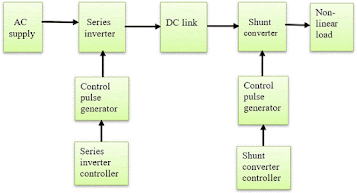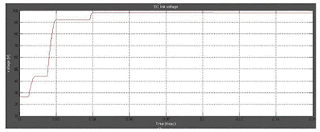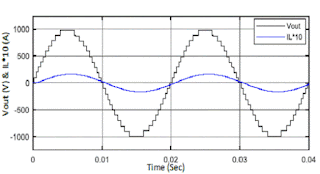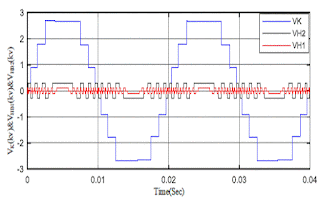ABSTRACT:
This paper presents a novel control strategy for the
operation of a direct-drive permanent-magnet synchronous generator- based
stand-alone variable-speed wind turbine. The control strategy for the
generator-side converter with maximum power extraction is presented. The
stand-alone control is featured with output voltage and frequency controller
that is capable of handling variable load. The potential excess of power is
dissipated in the dump-load resistor with the chopper control, and the dc-link
voltage is maintained. Dynamic representation of dc bus and small-signal analysis
are presented. Simulation results show that the controllers can extract maximum
power and regulate the voltage and frequency under varying wind and load
conditions. The controller shows very good dynamic and steady-state performance.
KEYWORDS:
1.
Maximum power
extraction
2.
Permanent magnet
synchronous generator (PMSG)
3.
Switch-mode rectifier
4.
Variable-speed
wind turbine
5.
Voltage and
frequency control
SOFTWARE: MATLAB/SIMULINK
BLOCK DIAGRAM:
Fig.1. Control structure of a PMSG-based
stand-alone variable-speed wind turbine.
EXPECTED SIMULATION
RESULTS:
Fig. 2. Response of the system for a step change of wind speed from 10 to 12 to 9 to 10 m/s. (a) Wind speed. (b) Generator speed. (c) Turbine torque and torque reference. (d) Torque reference and generator electromagnetic torque. (e) DC current reference and dc current. (f) DC power output.
Fig. 3. Optimum torque and generator torque.
Fig. 4. Turbine mechanical input power and electrical output power.
Fig. 5. Instantaneous and rms voltage and currents at a constant load (full load). (a) Instantaneous load voltages. (b) RMS line voltage. (c) Instantaneous line currents. (d) RMS line current.
Fig. 6. DC-link voltage, rms load voltage, rms line current, frequency, and modulation index at a constant load (full load). (a) DC-link voltage. (b) RMS load voltage (L–L). (c) RMS load current. (d) Frequency. (e)Modulation index.
Fig. 7. Instantaneous and rms voltage and current responses when the load changes from 100% to 50% and from 50% to 100%. (a) Instantaneous load voltages. (b) RMS line voltage. (c) Instantaneous line currents. (d) RMS line current.
Fig. 8. Response of dc-link voltage, rms load voltage, rms line current, frequency, and modulation index when the load changes from 100% to 50% and from 50% to 100%. (a) DC-link voltage. (b) RMS load voltage (L–L). (c) RMS load current. (d) Frequency. (e) Modulation index.
CONCLUSION:
A
control strategy for a direct-drive stand-alone variable speed wind turbine
with a PMSG has been presented in this paper. A simple control strategy for the
generator-side converter to extract maximum power is discussed and implemented
using Simpower dynamic-system simulation software. The controller is capable of
maximizing output of the variable-speed wind turbine under fluctuating wind.
The load-side PWM inverter is controlled using vector-control scheme to
maintain the amplitude and frequency of the inverter output voltage. It is seen
that the controller can maintain the load voltage and frequency quite well at
constant load and under varying load condition. The generating system with the
proposed control strategy is suitable for a small-scale stand-alone
variable-speed wind-turbine installation for remote-area power supply. The
simulation results demonstrate that the controller works very well and shows
very good dynamic and steady-state performance.
REFERENCES:
[1]
S. Müller, M. Deicke, and R. W. De Doncker, “Doubly fed induction generator
system for wind turbines,” IEEE Ind. Appl. Mag., vol. 8, no. 3, pp.
26–33, May 2002.
[2]
H. Polinder, F. F. A. Van der Pijl, G. J. de Vilder, and P. J. Tavner,
“Comparison of direct-drive and geared generator concepts for wind turbines,” IEEE
Trans. Energy Convers., vol. 3, no. 21, pp. 725–733, Sep. 2006.
[3]
T. F. Chan and L. L. Lai, “Permanent-magnet machines for distributed generation:
A review,” in Proc. IEEE Power Eng. Annu. Meeting, 2007, pp. 1–6.
[4]
M. De Broe, S. Drouilhet, and V. Gevorgian, “A peak power tracker for small
wind turbines in battery charging applications,” IEEE Trans. Energy Convers.,
vol. 14, no. 4, pp. 1630–1635, Dec. 1999.
[5]
R. Datta and V. T. Ranganathan, “A method of tracking the peak power points for
a variable speed wind energy conversion system,” IEEE Trans. Energy Convers.,
vol. 18, no. 1, pp. 163–168, Mar. 1999.







































